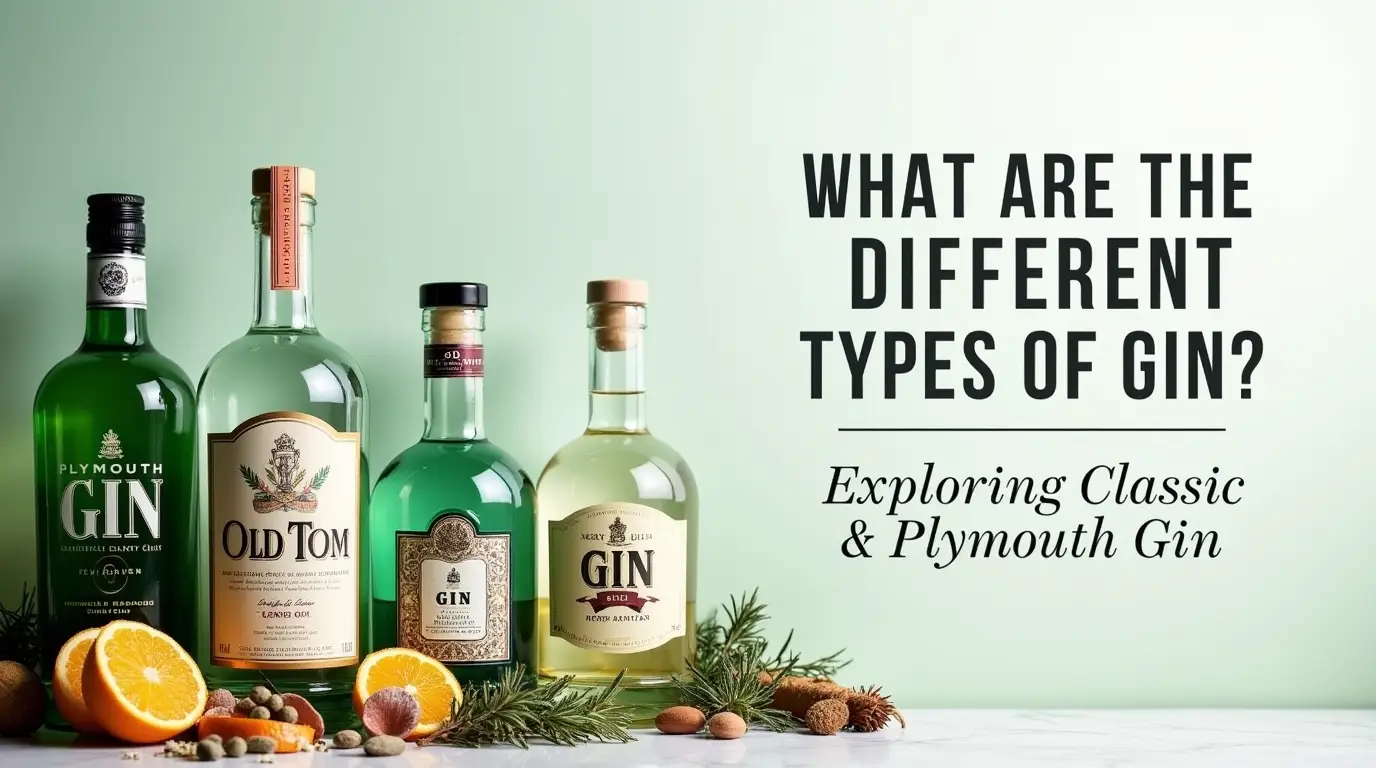Gin is more than just a clear spirit—it’s a story in a glass. From its origins as a medieval medicinal tonic to its place today as the backbone of countless cocktails, gin has evolved with every era of history. Politics, war, and innovation all played a role in shaping the vibrant and diverse spirit we now enjoy in many different gin styles around the world.
A Brief History of Gin
The story of gin begins in medieval Europe, where juniper-flavoured spirits were first used for medicinal purposes. By the 16th century, Dutch distillers had refined this into genever, a malt-based spirit infused with botanicals. British soldiers encountered it during the Thirty Years’ War, bringing home both the drink and the nickname “Dutch Courage.”
Gin’s popularity surged in late 17th-century England under King William of Orange, when restrictions on French brandy encouraged local distilling. This led to the infamous Gin Craze in London, a time of mass production and widespread consumption. By the 19th century, the invention of the column still allowed for a cleaner base spirit, paving the way for the crisp and unsweetened London Dry Gin. As the British Empire expanded, gin travelled with it—giving rise to iconic serves like the Gin & Tonic in India and the Gimlet at sea.
Learn more about gin’s history and development: https://en.wikipedia.org/wiki/Gin
What Is Gin? A Simple Definition
For all its rich history, the definition of gin is refreshingly straightforward: it’s a distilled spirit where the dominant flavour must come from juniper berries. This legal requirement, recognised in both the U.S. and the European Union, is what sets gin apart from all other spirits and gives it a unique identity across different types of gin.
The base spirit can be made from grains such as wheat or barley, or even grapes and potatoes. What truly defines gin is the infusion of juniper and other botanicals during distillation. This is also what separates it from vodka. While vodka strives for neutrality, gin is built for flavour—layered, aromatic, and endlessly versatile.
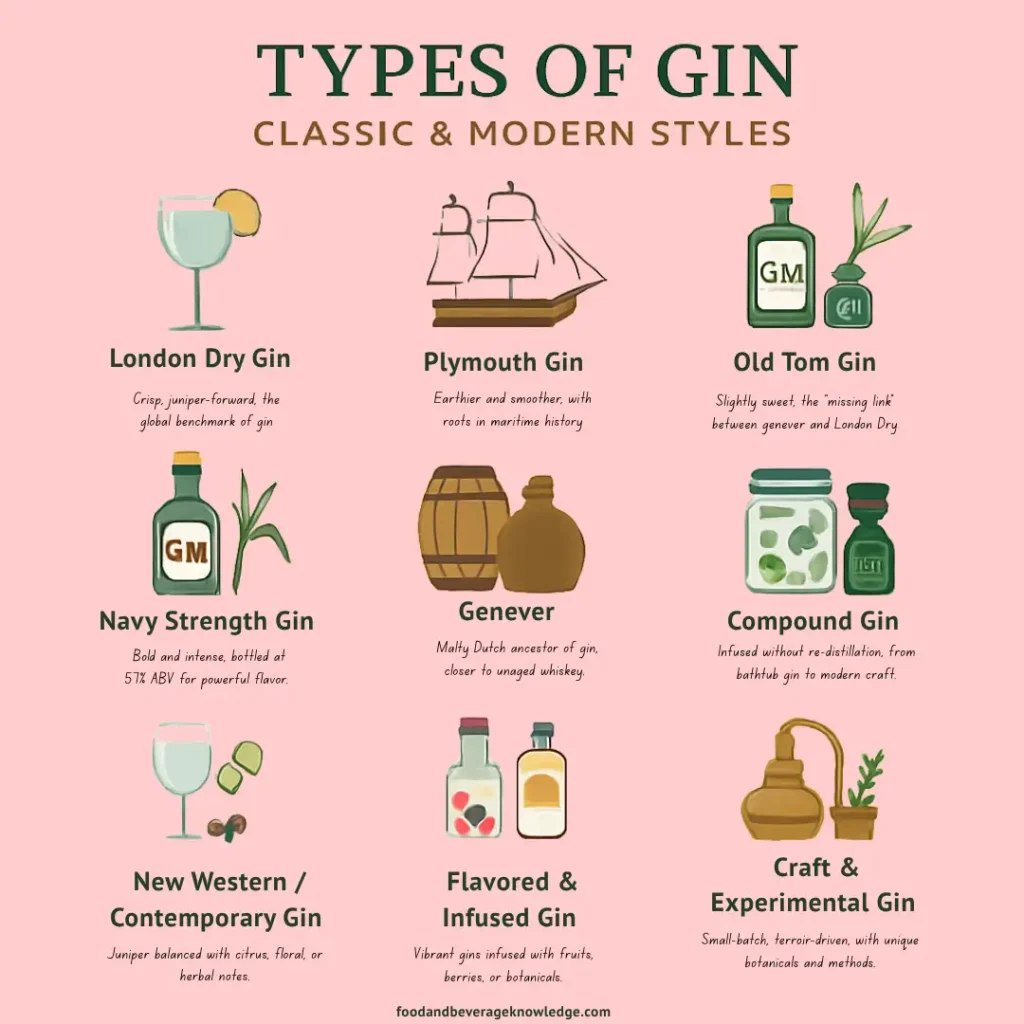
The Main Types of Gin: Classic and Historic Styles
Before exploring today’s modern gin innovations, it’s important to understand the classic styles that shaped the spirit’s identity. Each of these historic types of gin—London Dry, Plymouth, Old Tom, Genever, and others—has its own story, production method, and signature flavour. Together, they form the foundation of the gin world and remain essential for anyone looking to appreciate the full diversity of this timeless spirit.
Also Read: What Are the Different Types of Champagne?
London Dry Gin
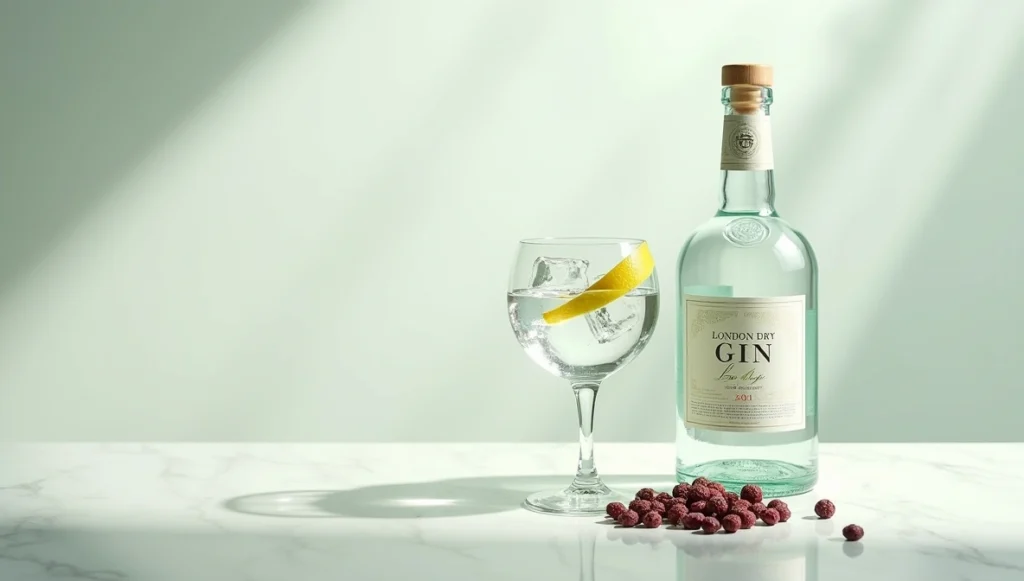
London Dry Gin is the most recognisable style of gin and serves as the benchmark against which many other gin styles are measured. Despite its name, it doesn’t have to be produced in London—the term refers to a strict method of production rather than a place of origin.
History and Production
The London Dry style emerged in the 19th century, enabled by the invention of the column still, which produced a high-purity neutral spirit. This allowed distillers to create a clean, unsweetened gin without masking impurities with sugar or heavy botanicals, as was common in earlier styles like Old Tom. The “Dry” label highlights this lack of sweetness.
Under EU regulations, a London Dry Gin must:
- Be made exclusively from ethyl alcohol of agricultural origin.
- Be flavoured solely through re-distillation with natural botanicals; all flavours must be added during a single distillation.
- Contain no artificial flavours or colourings; nothing can be added post-distillation except water and minimal sugar (≤0.1 g/L).
- Be bottled at a minimum of 37.5% ABV.
Flavor Profile
London Dry Gin is crisp, clean, and robust. Juniper is always the star, providing a pine-forward backbone, while supporting botanicals such as citrus peels, angelica root, and coriander, which add brightness, spice, and subtle earthiness.
Notable Brands
Some of the most iconic London Dry Gins include:
- Beefeater – classic nine-botanical recipe
- Tanqueray – bold, juniper-heavy flavour
- Sipsmith – a key player in London’s modern craft distilling revival
This style remains the foundation of many classic cocktails and is often the first choice for bartenders and enthusiasts exploring the world of gin types.
Plymouth Gin
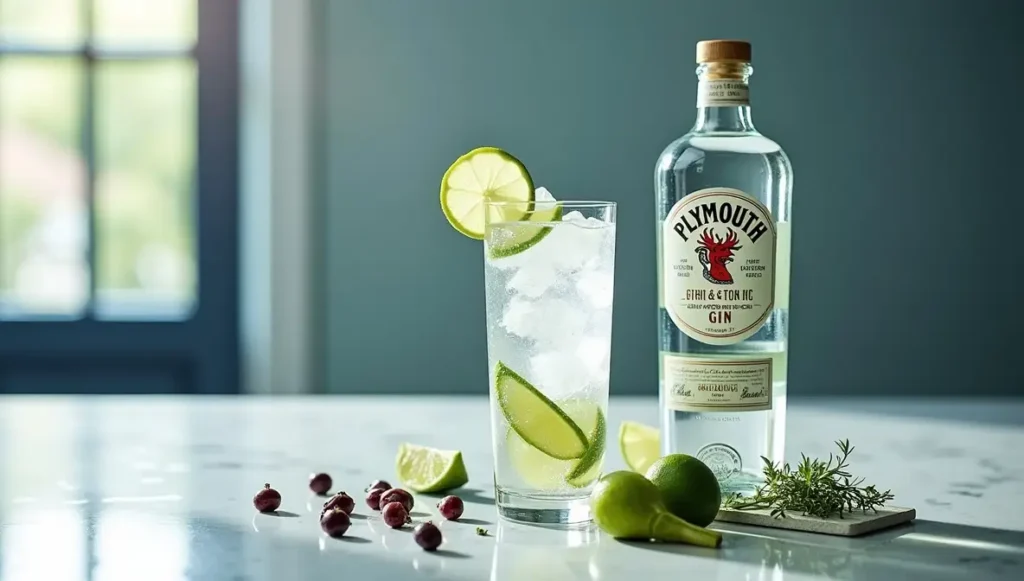
Unlike most gin styles, Plymouth Gin is defined not by production methods but by place. Its Protected Geographical Indication (PGI) requires that it be produced within the city of Plymouth, a historic maritime port in southwest England. This unique status, granted in the 1880s, helped protect its reputation against imitators.
The Sole Producer and Historical Significance
Plymouth Gin is made exclusively at the Black Friars Distillery, in operation since 1793, and is the oldest working gin distillery in England. Its history is closely tied to the British Royal Navy, as Plymouth was a key naval port, and the distillery supplied the fleet with barrels of gin, spreading its fame worldwide.
Flavor Profile
Compared to London Dry Gin, Plymouth Gin is softer and fuller-bodied. Juniper is present but less dominant, allowing root botanicals like angelica and orris root to give it an earthy, smooth character. The use of soft Dartmoor water adds to its texture, making it versatile for both sipping and cocktails.
Plymouth Gin’s unique profile and maritime heritage make it one of the most historic and distinctive types of gin available today.
Old Tom Gin
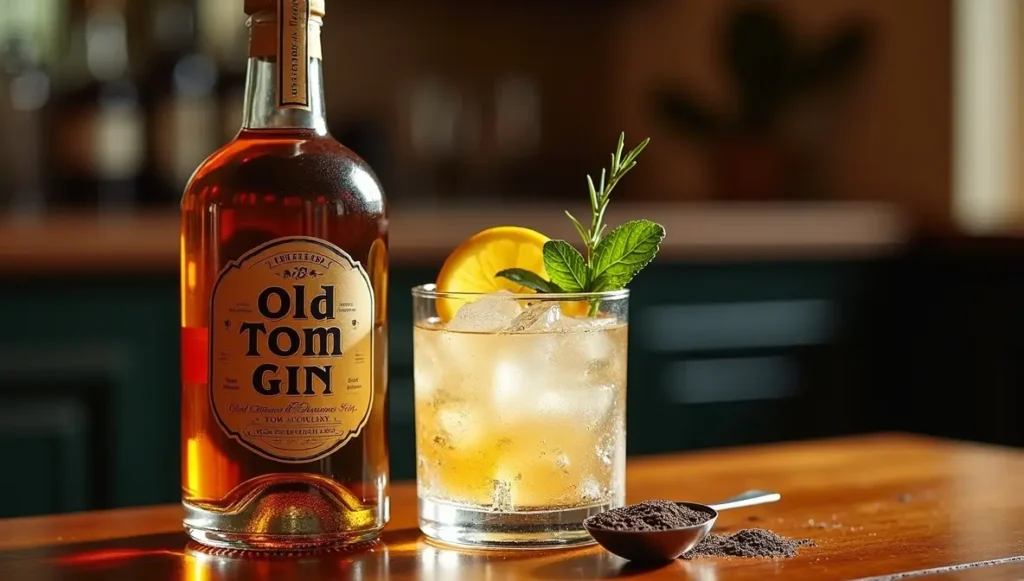
Old Tom Gin is often called the “missing link” between the malty, heavy genever and the crisp, modern London Dry. This style takes us back to the lively taverns of 18th-century England, offering a taste of gin history with a touch of sweetness.
Origins and the “Old Tom” Legend
During the Gin Craze, pot stills produced a harsh spirit, so distillers sweetened it with sugar or botanicals like licorice root to make it more approachable. The name “Old Tom” comes from a clever legend: pubs would display a black cat plaque on the exterior wall, and patrons would insert a coin under its paw. Bartenders inside would then dispense gin through a hidden tube, allowing an anonymous, discreet transaction despite the restrictive Gin Acts.
Flavour Profile and Cocktail Role
Old Tom Gin is sweeter than London Dry but drier than Dutch genever, with a rounded, full-bodied character. Its balanced sweetness made it a key ingredient in classic 19th-century cocktails such as the Martinez (a Martini precursor) and the Tom Collins, which was named after the style itself.
Modern Renaissance
After fading in popularity during the 20th century, Old Tom Gin has experienced a revival thanks to the craft cocktail movement. Distillers like Hayman’s of London and Ransom Spirits have resurrected historic recipes, bringing this historic style back to life for modern gin enthusiasts.
Popular Old Tom Gins
- Hayman’s Old Tom Gin – Classic revival from a 19th-century recipe, soft and slightly sweet.
- Ransom Old Tom Gin – American style, barrel-aged with a malty depth.
- Jensen’s Old Tom Gin – Small-batch London gin, drier yet true to tradition.
Navy Strength Gin
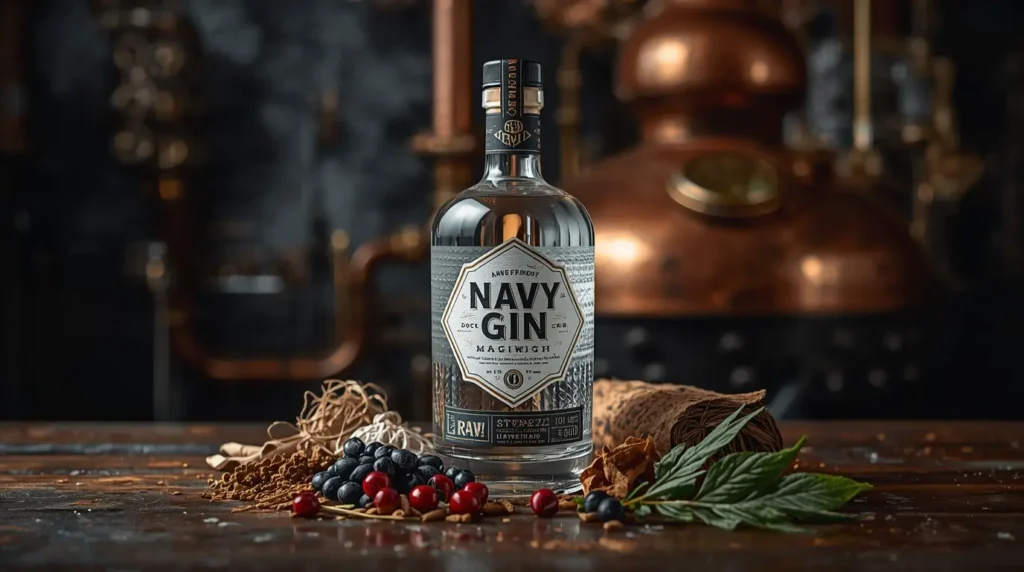
Navy Strength Gin is defined by one unmistakable feature: its high alcohol content. Bottled at a minimum of 57% ABV (114 proof in the U.S.), this style is both bold and intense, earning a special place among gin types for those who appreciate a stronger, more flavorful spirit.
Naval Lore and Definition
The name is linked to the Royal Navy, where gin was stored on ships alongside gunpowder. The legend goes that if a cask leaked, the gin had to be strong enough to allow the powder to ignite. While this story may be more marketing than history, the 57% ABV standard has become the defining mark of Navy Strength Gin.
Flavor Profile
The higher proof does more than add heat—it amplifies the botanicals, creating a richer, spicier, and more aromatic gin. The intensified flavors give it a bold character, with notes of juniper, citrus, and spice standing out more prominently than in standard gins.
A Cocktail Powerhouse
Navy Strength Gin excels in cocktails where a strong spirit is needed. Its robust profile holds up in classics like the Negroni, standing firm against bitter Campari, or in a Gin & Tonic for those seeking extra punch. Its intensity makes it ideal for bartenders and enthusiasts looking to explore bolder gin styles.
Popular Navy Strength Gin Brands
- Plymouth Navy Strength – A bold 57% ABV version of the iconic Plymouth Gin, historically linked to the British Royal Navy.
- Sipsmith VJOP (Very Junipery Over Proof) – London’s craft classic, supercharged with juniper at 57.7% ABV.
- Hayman’s Royal Dock Navy Strength – Inspired by the family’s gin supplied to the Royal Navy in the 19th century, bottled at 57% ABV.
Genever (Jenever)
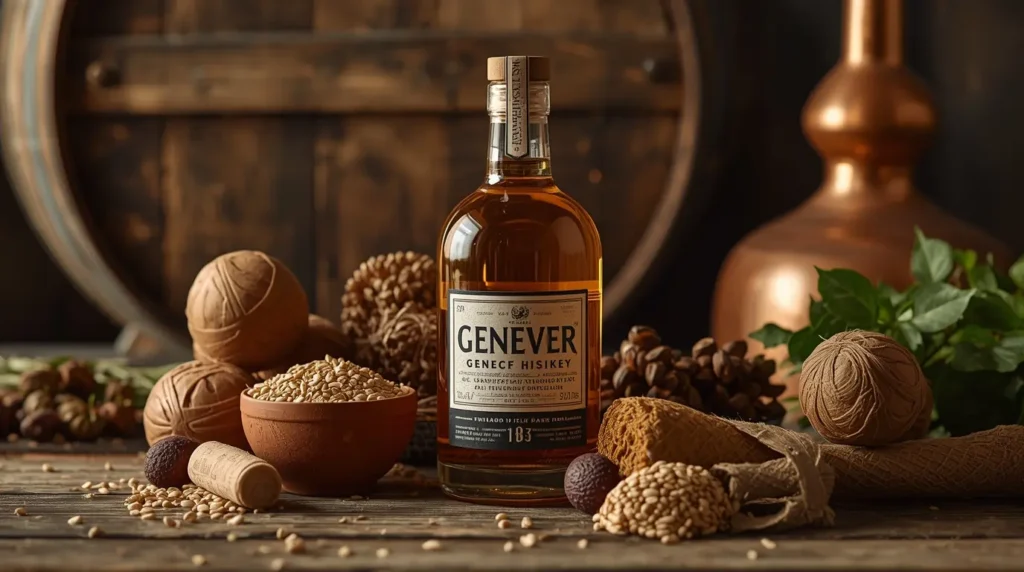
Before modern gin existed, there was genever, the Dutch and Belgian spirit that laid the foundation for today’s gin styles. Unlike contemporary gins, genever is a distinct category with its own production method, flavor profile, and heritage.
History and Production
Genever is gin’s direct forefather, defined by its base of malt wine (moutwijn)—a grain spirit made from corn, wheat, and rye, similar to an unaged whiskey. This malt wine is then either blended with a neutral spirit or re-distilled with botanicals, including juniper. The result is a rich, malty, and full-bodied spirit that stands apart from the cleaner, neutral base of modern gins.
Oude vs. Jonge Genever
There are two main styles of genever:
- Oude (Old) Genever – the traditional recipe with at least 15% malt wine, offering a malty, sweet, and aromatic profile. It often has a straw-colored hue.
- Jonge (Young) Genever – a modern style with no more than 15% malt wine, lighter, drier, and closer in character to London Dry Gin or vodka.
The Whiskey-Lover’s Gin
With its malty backbone, genever is sometimes described as a cross between gin and whiskey. It’s traditionally enjoyed neat, served ice-cold in a tulip-shaped glass, or paired with beer in a kopstootje. Its bold flavour also works in cocktails, including early versions of the Collins. Notable producers include Bols and Boomsma.
Genever’s rich history and distinctive taste make it an essential style for anyone exploring the main types of gin.
Compound Gin
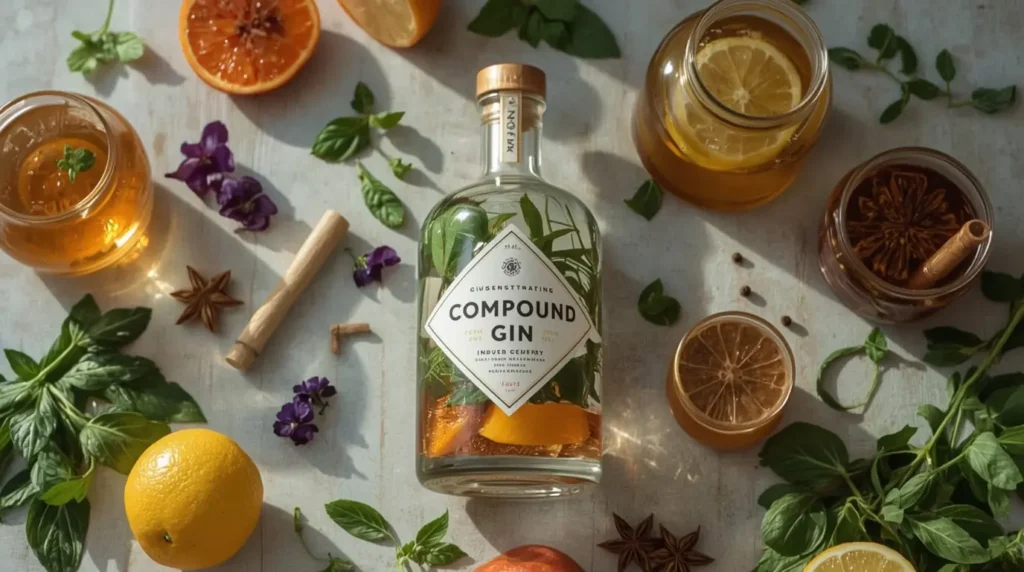
Unlike other gin styles, Compound Gin is defined by its method of production rather than flavour or origin.
Compound Gin is made by flavouring a neutral spirit with botanicals without re-distillation. The botanicals are simply steeped or macerated in the base alcohol—a method that is both simple and historic, and one of the earliest ways to create gin.
Historical Context: “Bathtub Gin”
This infusion method is famously linked to American Prohibition (1920–1933). Bootleggers would flavour harsh industrial spirits with juniper, herbs, and other botanicals in large containers—sometimes literally in a bathtub, giving rise to the term “Bathtub Gin.” While often low in quality and questionable in safety, this period became a defining chapter in gin’s history.
Modern Craft Applications
Today, the compounding method has been embraced by craft distillers as a legitimate way to innovate. Some delicate botanicals—like fresh flowers or certain fruits—lose their aroma when exposed to heat during distillation. By infusing them post-distillation, distillers can create vibrant, unique gins that highlight flavours impossible to achieve through traditional methods.
Compound Gin demonstrates how creative techniques and historical traditions continue to shape the diversity of modern gin styles.
Popular Compound Gins
- Bathtub Gin (Ableforth’s, UK) – A modern craft version inspired by Prohibition-era infusions.
- Sacred Gin (London, UK) – Uses vacuum distillation and infusion for delicate botanical flavours.
Also Read: What are the different types of beer?
The New Wave: Contemporary and Emerging Gin Styles
The 21st century has witnessed a global gin renaissance, a creative explosion that has shattered old conventions and redefined what the spirit can be. This modern movement is characterised by a departure from juniper-dominated tradition and a fervent embrace of innovation, local identity, and a pluralistic approach to flavour. This shift was not born in a vacuum; it is a direct response to a new generation of drinkers with more adventurous palates, a curiosity for craft, and a desire for spirits that tell a story.
New Western & Contemporary Gin
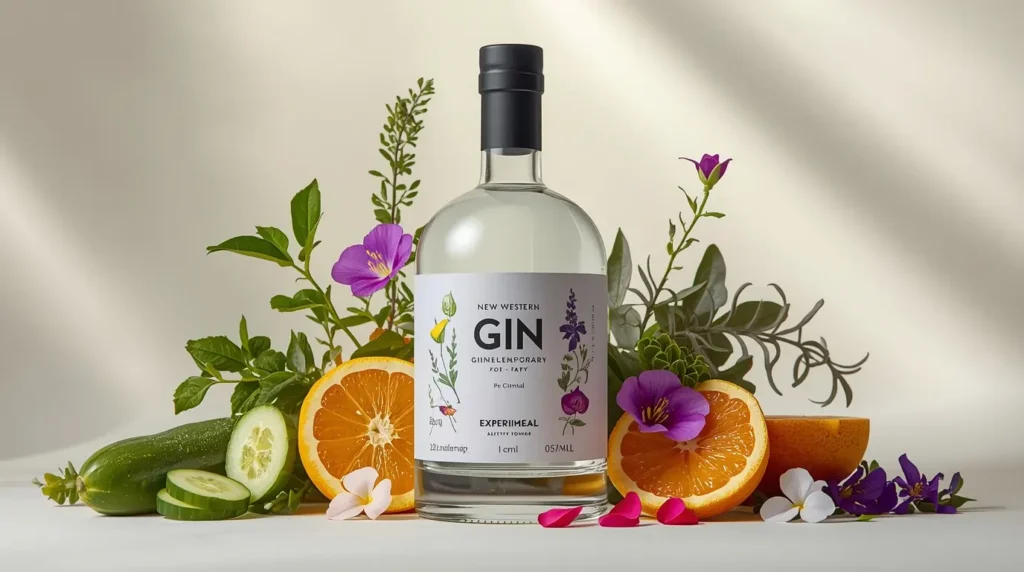
The modern gin movement has introduced a bold new style known as New Western, New American, or Contemporary Gin. Unlike traditional London Dry, these gins shift the focus away from juniper, letting other botanicals—floral, citrus, herbal, or spicy—take the spotlight. The result is a more balanced and approachable gin, appealing to adventurous modern palates.
“Contemporary Gin” is a stylistic, not legal, designation. Early pioneers in the U.S., and later globally, sought creative freedom beyond the strict London Dry rules. Today, distillers from Scotland to Japan are crafting gins that highlight the full botanical spectrum, prioritising flavour diversity over juniper dominance.
Pioneering Brands:
- Hendrick’s Gin (Scotland) – rose and cucumber infusion
- Aviation American Gin (U.S.) – smooth, approachable flavour
- St. George Spirits (U.S.) – terroir-driven botanical focus
Flavoured & Infused Gins
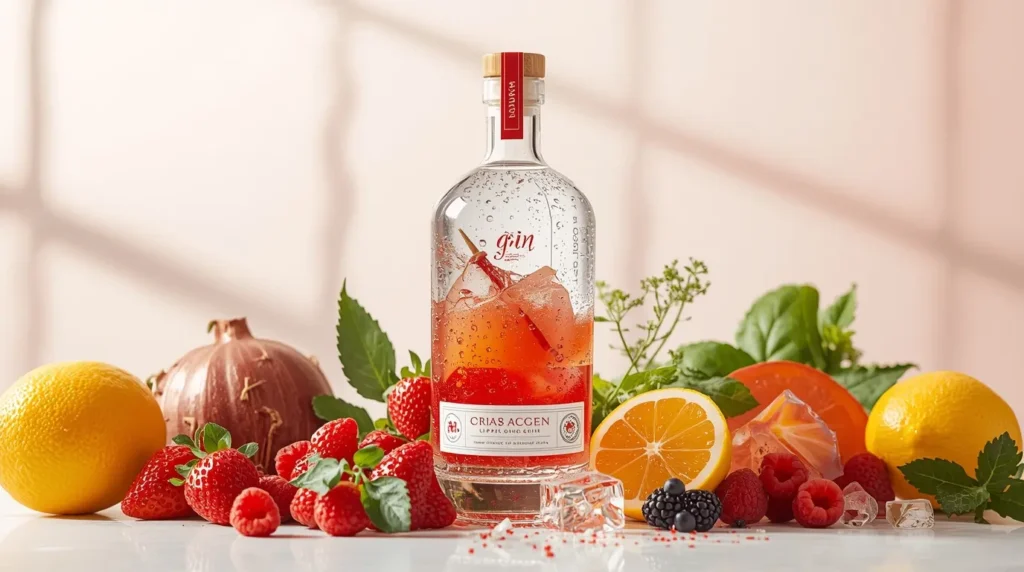
Riding the wave of creativity, flavoured and infused gins bring a wide range of colours and tastes to the market. These gins are often flavoured post-distillation using infusion or maceration.
Key Sub-types:
- Pink Gin – gins colored/flavoured with red fruits like strawberries, raspberries, or rhubarb; typically sweeter and approachable.
- Sloe Gin – a traditional English liqueur made by steeping sloe berries in gin, with added sugar; lower in ABV (15–30%).
- Fruit & Herbal Gins – includes citrus-forward gins (e.g., Malfy with Sicilian lemons) and experimental creations like gins infused with pickles or herbs.
Popular Flavoured Gins
- Malfy Gin Rosa (Italy) – Infused with Sicilian pink grapefruit and rhubarb.
- Whitley Neill Rhubarb & Ginger Gin (UK) – A best-seller combining tart rhubarb with warming ginger.
- Beefeater Blood Orange (UK) – A bold, citrus-forward gin with sweet and zesty notes.
Craft & Experimental Gins: The Spirit of Terroir
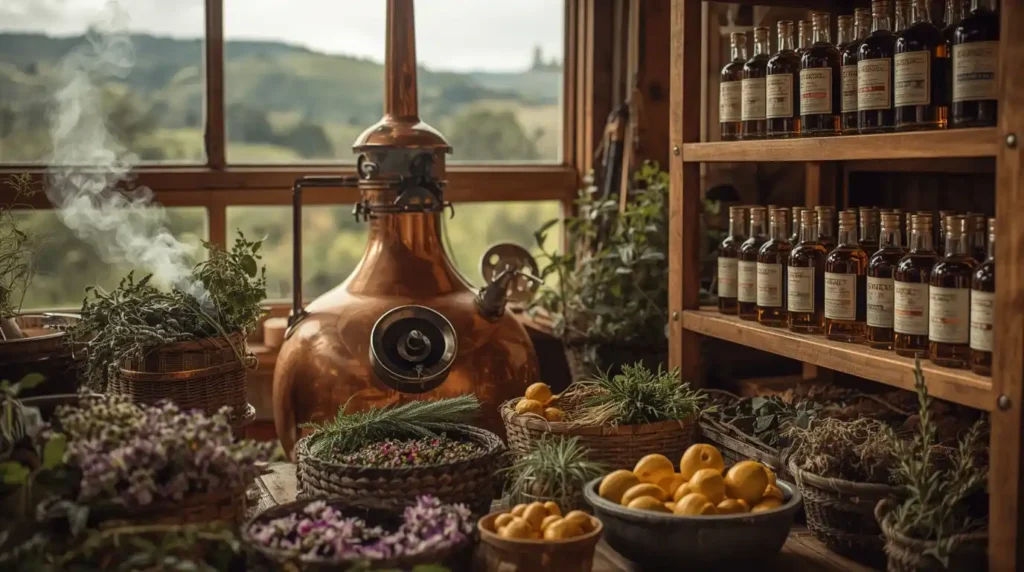
The craft gin movement emphasises small-batch production, artisanal quality, and a sense of place.
Philosophy and Production: Craft gins are typically produced by a single distiller or small team who oversee every step—from ingredient selection to bottling—ensuring precision and a personal touch.
Regional Botanicals & Terroir: Many craft distillers highlight local ingredients to reflect the spirit’s origin. Examples include Scottish gins using Kinrara Estate rose and cardamom or New York gins using local apples or potatoes. This creates unique flavour profiles and a compelling narrative connecting the gin to its home.
Innovation: Craft distillers drive innovation in the gin world, experimenting with unusual base spirits, novel botanicals, and techniques like vacuum or cold distillation, which preserve delicate aromas lost in traditional heating methods.
Related article:
- Classification and Types of Beverages: Alcoholic and Non-Alcoholic Explained
- The Ultimate Guide to Draft & Draught Beer: Everything You Need to Know
- Top 13 Most Popular Beer Brands in the World, Country, ABV
- What Is Fortified Wine? Types, Production and Flavor Profiles
FAQs
What is gin made from?
A neutral spirit flavoured with juniper and other botanicals. It can be made from grains, potatoes, or grapes.
How is gin different from vodka?
Vodka is neutral and flavourless; gin is aromatic and defined by juniper and botanicals.
What are the main types of gin?
London Dry, Plymouth, Old Tom, Navy Strength, Genever, and Compound Gin.
What is Contemporary or New Western Gin?
Gins where juniper takes a backseat and other botanicals like citrus, herbs, or flowers define the flavor.
Subscribe and join our community of hospitality professionals & students — get insights, tips, and the latest updates delivered straight to your inbox!

